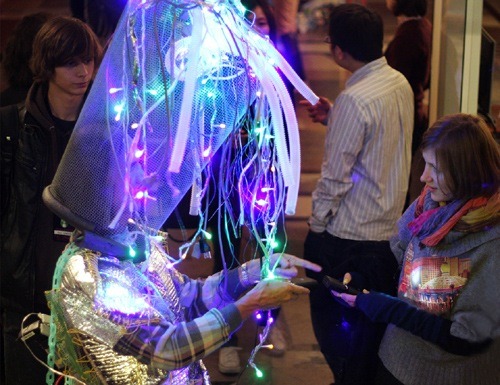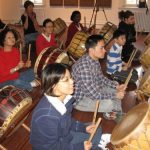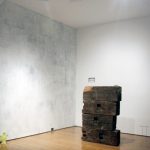Meet a NYFA Artist: Chin Chih Yang
NYFA speaks with Fellow in Digital/Electronic Arts, 2008, Chin Chih Yang.
NYFA: Hello Chin Chih, thank you so much for speaking with us. Can you tell us about what you’re currently working on and what’s coming up for you?
CCY: Yes, I am working on several projects. “Kill Me or Change” is an interactive performance art installation that will happen at the Queens Museum of Art. Outside the museum on July 28 and 29, 2012, 30,000 aluminum beverage cans will be progressively dropped on my head from a crane above, ultimately burying me under a mountain of shiny, colorful, and ubiquitous aluminum waste. As a preview, on April 22, Earth Day, I will hang a bundle of 1,000 cans suspended by netting above the heads of museum visitors, who can “adopt” the cans that will be used by signing a can or writing comments, and they can also attend an all-day workshop with me and make their own can artworks. “Kill Me or Change” attempts to highlight the impact of personal consumption on the environment, and the importance of recycling. “Kill Me or Change” is supported by Franklin Furnace, the Lower Manhattan Cultural Council, Passport to Taiwan, Wassaic Project, Taiwan Tzu-Chi Foundation, Godwin-Ternbach Museum-Queens College, the New York Foundation for the Arts, and the Queens Museum.
Second, my work is included in a group exhibitions, “Pith Paper,” at the Hsinchu Culture Bureau in Taiwan through May 16 and I have a sculpture/installation in “Mathematics of Light” at the sian Arts Gallery, Towson University, Towson, MD from June 29 to 31st. The gallery writes about this piece: “Utilizing LED lights and light projections, “Mathematics of Light” is a sculpture/installation made of beverage cans and other recyclable materials, which signals a conservation aesthetic in a society that is, for the most part, dedicated to waste. Not only do the cans have aesthetic features, such as shape, color, texture, and a particular relationship to light, they are themselves representations of what might have gone on to pollute the planet, had they not been put to more creative ends. Essential to “Mathematics of Light” is the use of modern and emergent technologies, enabling the artist to create an immersive environment that participants can interact with and even move about in.”
I also have solo show opening at FiveMyles Gallery in Brooklyn on May 5, closing June 6.
NYFA: Your work speaks to both ecological and psychological catastrophe. How are these related for you?
CCY: I was born in Taiwan and grew up on a farm in the countryside, which gave me an understanding and appreciation of nature and the environment. When I was a young boy, my grandfather told us that Chang Kai-shek had killed many Taiwanese people, and for many years people were scared and could not speak freely. When I was in the Taiwanese Army, I was made to work very hard with little rest, and suffered a minor stroke with partial facial paralysis as a result. Martial law in Taiwan was implemented in 1949 and not lifted until 1987, a period of 38 years, the longest imposition of martial law anywhere in the world.
Also, in New York, the events of 9-11 at the World Trade Center occurred only a few blocks from where I was living, which was a traumatic experience for my family.
NYFA: How does participation by audiences and spectators change from a gallery or performance-space context to a public context?
CCY: A gallery is an enclosed space, which is very different from an open, public space. For many years I’ve been in the art field, and I’ve always tried to figure out how exhibitions could be improved. I think the gallery space is good for many projects, but not for all projects.
An indoor gallery space always reduces audience interaction to some extent, because viewers have to make their way to a particular space to see a work. I try to set things up so that people can interact naturally with my work, whether in a gallery or an unmarked public setting—to best reach people and communicate something.
NYFA: Can you tell us about your process—do you usually conceive of your actions and performances entirely in your mind first, or do you discover them through experimentation?
CCY: My daily experiences inform how I conceive my work, whether performance or installation, or some melding of the two. Interactions and conversations with others generally shape the ideas expressed in my work. Also, if something really touches me in the news, it really motivates me to do something—especially when tragic situations befall small children.
NYFA: What is your studio or workspace like?
CCY: I used to have a very good studio for a while, but because my work is changing all the time and I change my way using the space, —but also my art process also is changing. In a way, everywhere I go is my studio.
I have small spaces in three different locations: Queens, Manhattan, and upstate NY. I don’t have a big studio—I just use my living or any spaces as my studio; and I also share studio space with other people. But I’ve found this to be an interesting way to work. I’m a living artist, whose art and life overlap.
NYFA: Who or what is influencing you most strongly at the moment?
CCY: I’m not really especially influenced by a particular person or “master.” I don’t want to live in anyone’s shadow. I am wholly influenced by the particulars of our society, however. Especially the tragic aspects, which my works seeks to comment on.
I grew up as a farmer in Taiwan, and from that I came to love nature. In a way, nature has always been my primary source of inspiration and influence. Not only nature’s tender aspects, but it’s frightful ones, too. What influences me most now is injustice. How are we going to solve this problem? I think about this all the time. How can we make our society just? It’s good to think and talk about these things. I always say I don’t believe in religion—but I also think the selfishness in our hearts is a source of problems. These things daily influence me. I am always asking myself: How can I make art that improves things?
NYFA: What is the biggest challenge that you face, ideologically, economically, aesthetically, or otherwise?
CCY: Ideologically, the biggest challenge for me is to communicate through art to as many people as possible.
Of all the billions of people on Earth, I only know a handful. But I strive to communicate truly, from my heart. I feel the effects of globalization, and our society, financial system, and economic structure are still not sufficiently advanced to catch up to the positive potential in our technologies. Economic structures influence our natural environment, because of pollution—mainly due to corrupt businesspeople indifferent to the damage to nature and human health.
We need to figure out a way to protect our natural life and our society, instead of perpetuating these wrong priorities—material production over quality of life.
Not everyone was lucky enough to have attended your Artists & Audiences Exchange talk at Harvestworks this Spring. Will you be so kind as to share some of your ideas about The Use and Abuse of Technology in the Arts in written form?
I talked about what humans will become if modified by technological devices. Our future bodies will probably be significantly modified by technical appendages. The audience and I discussed the potential of the human body, and the potential of technology as a fully integrated means of communication.
Technology depends on how you use it, and for me, it’s most ideally used for meaningful ends—not just as a device or gimmick, but a tool toward the communication of a message. Too often I see this lacking in artworks.
NYFA: How did the NYFA Fellowship affect you? What did it go towards?
CCY: I have been very happy to have the NYFA fellowship, which enabled me to do a lot of work on my projects. For the “Broken Mind” project I was able to buy more equipment, like a small projector; and for my new project “Building a future human” I bought a voice tone creator; for “Kill Me or Change” I procured production material like fish netting and more; I was able to buy a better camera to document my projects; and I also was enabled to do lots of research. I also able to send my kids back to Taiwan to create the project I call “Family Value.” The NYFA Fellowship has really helped me to improve my art career, and do the art projects I want to do.
Learn More about Chin Chih Yanghere.





